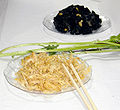- Codonopsis lanceolata
-
Codonopsis lanceolata 
Scientific classification Kingdom: Plantae (unranked): Angiosperms (unranked): Eudicots (unranked): Asterids Order: Asterales Family: Campanulaceae Genus: Codonopsis Species: C. lanceolata Binomial name Codonopsis lanceolata
(Siebold.&Zucc.)Trautv.Codonopsis lanceolata is a flowering plant. It originates from China and Japan. It is a variety of bonnet bellflower.
The roots are used in Korean cuisine, where it is called deodeok (더덕).
It is used in Korean dishes such as deodeok kimchi (더덕김치), deodeok jeon (더덕전), deodeok gui (더덕구이), deodeok saengchae (더덕생채), and changui (찬구이).
Codonopsis lanceolata is also used as a natural medicine[1].
A hardy perennial climber that grows up to 1.5m tall. It has bell shaped flowers that are purple inside and flowers from August to September and the seeds ripen from September to October. The flowers are hermaphrodite and are pollinated by bees and wasps.
Specialist info (Cultivation, Propagation method, Pests, treatments, uses, historic) It grows in moist areas in woodland on low hills or mountains at an elevation of 200-1600m. The plant likes light and medium well drained soils with plenty of moisture with a neutral to acidic ph. It likes full sun to semi-shade. The leaves and roots of the plant are edible raw or cooked. The plant has many medical uses and is used to treat lung abscesses, milk-flow obstruction and inflamed boils among many others. Slugs and snails eat young growth. The plant is propagated by seed which is surface-sown onto ericaceous compost. Division is also possible although great care must be taken as the plant hates root disturbance.
The plant is grown commercially in Hoengseong County, Gangwon Province, South Korea, where it is an important part of the local agriculture. However, many South Koreans grow a small amount in personal gardens.Gallery
-
A plate of sliced Korean Codonopsis lanceolata roots with pine nuts (foreground)
-
A plate of deodeok gui, a Korean dish made from Codonopsis lanceolata root marinated in gochujang sauce and grilled over charcoal
References
External links

This Asterales article is a stub. You can help Wikipedia by expanding it. -


